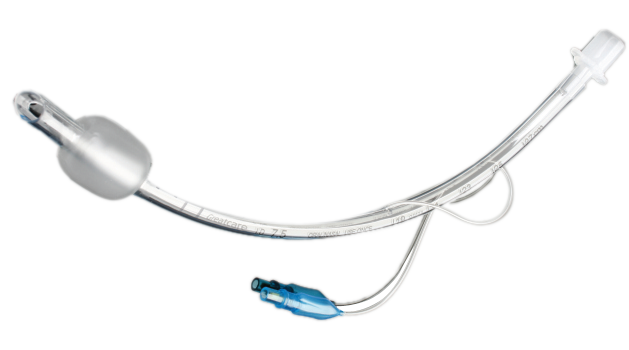
Manufactured with strong tube walls to ensure the proper ventilation for all patients. A variety of sizes ensures a safe airway is maintained throughout the surgery.
Endotracheal tubes are used to maintain an airway during surgery and other medical procedures. These tubes are inserted through the nose or mouth and into the trachea (windpipe). A high-volume, low-pressure cuff is placed around the tube to seal it in place and prevent air from leaking.
| Ref. No.: | Size: | Qty. Cs: |
|---|---|---|
| NMR100125 | 2.5 | 100 |
| NMR100130 | 3.0 | 100 |
| NMR100135 | 3.5 | 100 |
| NMR100140 | 4.0 | 100 |
| NMR100145 | 4.5 | 100 |
| NMR100150 | 5.0 | 100 |
| NMR100155 | 5.5 | 100 |
| NMR100160 | 6.0 | 100 |
| NMR100165 | 6.5 | 100 |
| NMR100170 | 7.0 | 100 |
| NMR100175 | 7.5 | 100 |
| NMR100180 | 8.0 | 100 |
| NMR100185 | 8.5 | 100 |
| NMR100190 | 9.0 | 100 |
| NMR100195 | 9.5 | 100 |
| NMR100110 | 10.0 | 100 |
Endotracheal tubes are used to maintain an airway during surgery and other medical procedures. These tubes are inserted through the nose or mouth and into the trachea (windpipe). A high-volume, low-pressure cuff is placed around the tube to seal it in place and prevent air from leaking.
An endotracheal tube is a tube that is inserted into the trachea (windpipe) through the nose or mouth. It is held in place by a cuff that inflates to seal the opening of the trachea. The tube is used to help a person breathe when they cannot do so on their own.
There are many different types of endotracheal tubes on the market today. Each type has its own set of features and benefits. Here, we will take a look at the three main types of endotracheal tubes: high-volume, low-pressure, and barrel-shaped cuffs.
High-volume cuffed endotracheal tubes are designed for patients who require a high volume of air to be delivered to their lungs. These tubes have larger cuffs that can accommodate a higher volume of air. Low-pressure cuffed endotracheal tubes are designed for patients who require a lower pressure of air to be delivered to their lungs. These tubes have smaller cuffs that can provide a more comfortable fit for the patient. Barrel-shaped cuffed endotracheal tubes are designed for patients who require a higher pressure of air to be delivered to their lungs. These tubes have larger cuffs that can provide a more comfortable fit for the patient.
There are both pros and cons to using cuffed high-volume, low-pressure, barrel-shaped cuffs. Some of the pros include that they can provide a good seal, they're less likely to leak, and they're less likely to cause trauma to the trachea. However, some of the cons include that they can be more difficult to insert, and they may not be as comfortable for the patient. Ultimately, it's up to the doctor to decide which type of cuff is best for each individual patient.
When it comes to choosing the right size cuff for your endotracheal tube, there are a few things you need to take into account. The first is the size of the patient's trachea. The second is the type of surgery being performed. And lastly, you need to consider the surgeon's preference.
Size
The size of the patient's trachea will determine the internal diameter (ID) of the cuff. The ID should be slightly smaller than the trachea so that when inflated, the cuff snugly fits and seal off the airway without causing any damage.
Type of Surgery
The type of surgery being performed will also dictate the size of the cuff. For example, if a patient is undergoing a procedure that requires intubation, a larger cuff is necessary to provide a tight seal. However, if a patient is only having a minor procedure, a smaller cuff may be all that is needed.
Surgeon's Preference
Lastly, you need to consider the surgeon's preference when selecting a cuff size. Some surgeons prefer a larger cuff for added security while others prefer a smaller cuff to minimize tissue trauma. Ultimately, it is up to the surgeon to decide which size
If you or a loved one has been recently intubated, it is important to know how to properly care for the endotracheal tube. Here are a few tips:
1. Keep the area around the tube clean and dry. This will help to prevent infection.
2. The tube should be secured in place with tape or a strap.
3. If the patient is able to talk, they should be encouraged to do so as this will help keep the lungs inflated and prevent pneumonia.
4. It is important to keep suctioning equipment close by in case of secretions buildup.
5. The patient should be turned every 2 hours to prevent bed sores.
By following these simple tips, you can help ensure that your loved one has a successful recovery from their intubation.